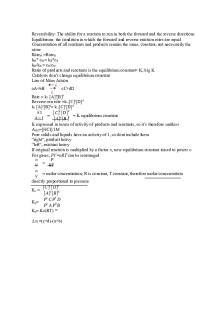Chemical Equilibrium + Acids & Bases PDF

| Title | Chemical Equilibrium + Acids & Bases |
|---|---|
| Course | Thermodynamics, Electrochemistry, Kinetics, and Organic Chemistry |
| Institution | University of California Los Angeles |
| Pages | 5 |
| File Size | 76.2 KB |
| File Type | |
| Total Downloads | 84 |
| Total Views | 170 |
Summary
Study guide for equilibrium and acids and bases...
Description
Chemical Equilibrium - Reaction at equilibrium: R ⇆ P - The concentrations of Reactants and Products are constant - Rate of forward reactions = rate of reverse reactions - Because of these two ideas → under same conditions reaction at equilibrium has same product over reactant ratio - This ratio is called the equilibrium constant, Kc< - Do not include units in the equation since the concentrations are approximations - Chemical activity doesn’t have units - Example: N2 (g) + 3H2 (g) ⇆ 2NH3 (g) at 500 degrees celsius - [NH3]2 / [N2] [H2]3 = Kc - If the reaction is reversed → 2NH3 (g) ⇆ N2 (g) + 3H2 (g) → 1/Kc - If all reactants and products are in same phase = homogeneous equilibrium - If one or more R and P are in different phase: heterogeneous equilibrium - Molar concentrations of a pure substance (solid or liquid) doesn’t change in a reaction → not include in Kc expression - Example: Ca(OH)2 (s) ⇆ Ca2+ (aq) + 2OH- (aq) → Kc = [Ca2+ ] [OH- ]2 - For a gas we use its partial pressure (P) and equilibrium constant is denoted as Kp - CaCO3 (s) ⇆ CaO (s) + CO2 (g) → Kp = [Pco2 ] - Often K is used to represent Kc or Kp - How to convert between partial pressure and concentration for a gas - Use ideal gas law → PV=nRT → P/RT= n/V - For concentration to partial pressure → nRT/V=P - For pressure into concentration P/RT=n/V -
Extra notes - Spectator ions are not included in the equilibrium expression - 10^5 Pa= 1 bar - If you are at equilibrium with concentration used and you add moles of a substance - You first have to see the added concentration (divide moles by volume) - Then add it with the equilibrium concentration of the same substance - Then set up an ice table with -x and +x values - If you add HI to the H2 + I2 -- 2HI place then there will be a an equilibrium shift to the left so ice table will be: +x +x -2x - Solvents are not included in the equilibrium constant expression - Equilibrium constants are useful because - They indicate the extent to which a reaction progresses to completion - The relative concentrations of products and reactants - Kc represents the equilibrium constant expression using the equilibrium molar concentrations of the products and the reactants
-
-
-
-
-
-
-
Kp represents the equilibrium constant expression using the equilibrium partial pressures of the reactants and products K and what it tells us - If K> 103 then reaction almost goes to completion before reaching equilibrium - Strongly favors product, more products than reactants, lies to the right - If K< 10-3 then equilibrium is reached relatively quickly - Strongly favors reactants, more reactants than products, strongly lies to the left, - If K> 1 then equilibrium lies to the right but not strongly. Equilibrium concentrations of product is greater than equilibrium concentrations of reatant - If K...
Similar Free PDFs

Acids and bases - Assignment
- 10 Pages

Acids, bases, equilibria & esters
- 44 Pages

Chemical equilibrium 1 report
- 9 Pages

Chemical Equilibrium I
- 9 Pages

2 Worksheet Acids and Bases
- 4 Pages

Acids and bases chart mk
- 1 Pages

Worksheet - Chemical Equilibrium
- 8 Pages

Acids and Bases review Ans
- 6 Pages

Chapter 14 - Acids and Bases
- 6 Pages

Chem Lab Acids and Bases
- 1 Pages

8.6 Acids and Bases - Notes
- 3 Pages
Popular Institutions
- Tinajero National High School - Annex
- Politeknik Caltex Riau
- Yokohama City University
- SGT University
- University of Al-Qadisiyah
- Divine Word College of Vigan
- Techniek College Rotterdam
- Universidade de Santiago
- Universiti Teknologi MARA Cawangan Johor Kampus Pasir Gudang
- Poltekkes Kemenkes Yogyakarta
- Baguio City National High School
- Colegio san marcos
- preparatoria uno
- Centro de Bachillerato Tecnológico Industrial y de Servicios No. 107
- Dalian Maritime University
- Quang Trung Secondary School
- Colegio Tecnológico en Informática
- Corporación Regional de Educación Superior
- Grupo CEDVA
- Dar Al Uloom University
- Centro de Estudios Preuniversitarios de la Universidad Nacional de Ingeniería
- 上智大学
- Aakash International School, Nuna Majara
- San Felipe Neri Catholic School
- Kang Chiao International School - New Taipei City
- Misamis Occidental National High School
- Institución Educativa Escuela Normal Juan Ladrilleros
- Kolehiyo ng Pantukan
- Batanes State College
- Instituto Continental
- Sekolah Menengah Kejuruan Kesehatan Kaltara (Tarakan)
- Colegio de La Inmaculada Concepcion - Cebu




